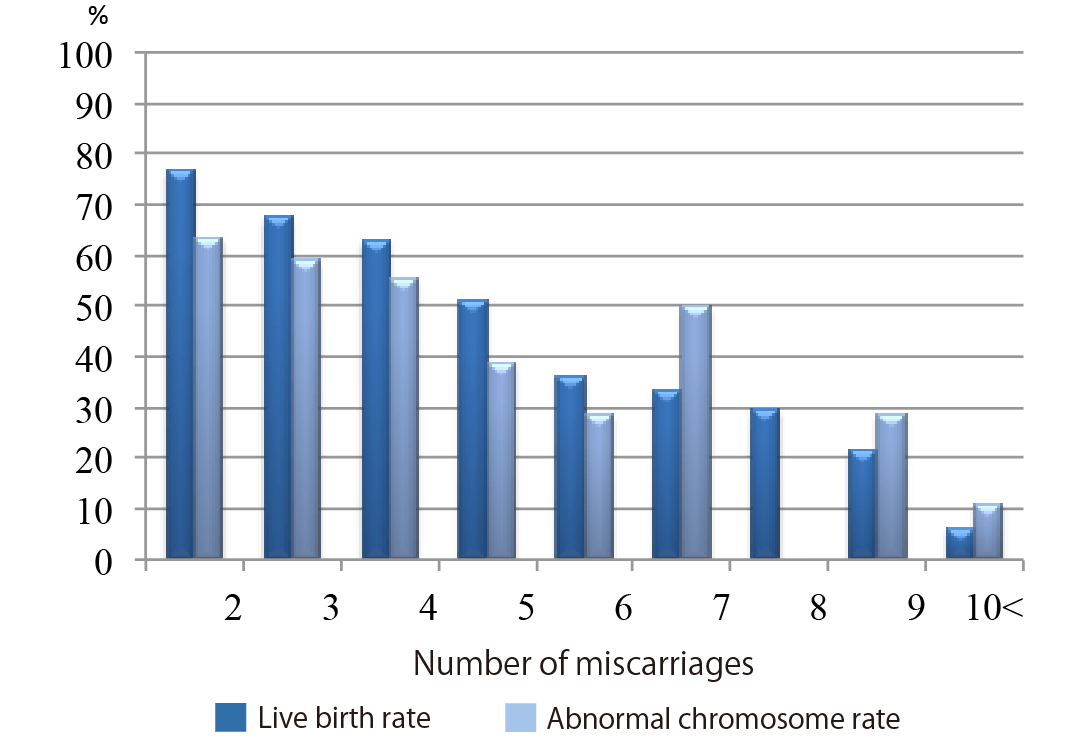For patients with recurrent pregnancy loss
Fetal or embryonic aneuploidy
Eighty percent of patients with two previous miscarriages, 70% with three, 60% with four, and 50% with five can give live birth in the next pregnancy without the need for medication.
Fifteen percent of these pregnancies result in miscarriage and about 80% of the fetuses or embryos have a chromosomal abnormality. The frequency of miscarriage increases with age, and aneuploidy also increases as a woman gets older.
We studied 1309 pregnancies in patients with RPL and found that the frequency of normal chromosomes was significantly higher in RPL than in patients with accidental sporadic miscarriages, and the success rate decreased as the number of previous miscarriages increased, as did the fetal chromosome aberration rate (Fig. 9, ref. 27). However, out of 2-4 of the previous miscarriages, more than 50% had chromosomal abnormalities.
Fetal chromosome aneuploidy was found to be an important cause of RPL. The success rate of the next pregnancy with a fetal chromosome abnormality was significantly higher than that with a normal fetal chromosome (62% vs. 38%, odds ratio 2.6). In other words, a fetal chromosome abnormality is a predictor of the next time that a woman will have a baby.
Figure 9: The live birth rate and frequency of fetal aneuploidy decrease as the number of previous miscarriages increases.
| Fetal or embryonic chromosome karyotype |
Accidental n=114 |
RPL n=234 |
|---|---|---|
| Normal | 23.7% | 48.7% |
| Abnormal | 72.3% | 51.3% |
| Trisomy | 72.3% | 52.5% |
| Double Trisomy | 0% | 5.8% |
| Monosomy | 5.7% | 4.2% |
| Triploidy | 16.1% | 15.0% |
| Others | 5.7% | 22.5% |
| Fetal chromosome | Live birth rate at next pregnancy |
|---|---|
| normal (n=71) | 38.0% |
| abnormal (n=60) | 61.7% (OR 2.6) |

Sugiura-Ogasawara et al. Fertil Steril 2000
Miscarriage increases with age. This is mainly due to the fact that the number of chromosomal distribution errors in the oocyte during meiosis increases as a woman gets older.
A survey of 482 couples who underwent fetal chromosome testing revealed that fetal chromosome aneuploidy was present in 41% of cases (Fig. 5 right, Ref. 6).
Patients who have had a miscarriage of unknown cause do not need to be medicated and have a reliable chance of success next time. Eighty percent of patients with two miscarriages, 70% with three, 60% with four, and 50% with five were able to give birth with the next pregnancy (Fig. 2, ref. 5). As mentioned earlier, those with confirmed fetal aneuploidy are considered to have a better prognosis.
Figure 10: The live birth rate according to the number of previous miscarriages

Katano et al. Fertil Steril 2013
← Please see by side-scrolling →
| age | The number of previous miscarriages | |||
|---|---|---|---|---|
| 2 | 3 | 4 | 5 | |
| 20 | 92 | 90 | 88 | 85 |
| 25 | 89 | 86 | 82 | 79 |
| 30 | 84 | 80 | 76 | 71 |
| 35 | 77 | 73 | 68 | 62 |
| 40 | 69 | 64 | 58 | 52 |
| 45 | 60 | 54 | 48 | 42 |
Bringham et al. Hum Reprod 1999
Index
- Definition of recurrent miscarriage and recurrent pregnancy loss and results of the Japan Environment and Children’s Study (JECS)
- Examination and causes of RPL
- Antiphospholipid syndrome
- ー
- Treatment of antiphospholipid syndrome
- Chromosomal translocation in either partner
- Preimplantation genetic testing for chromosomal structural rearrangement
- Congenital uterine anomaly
- Thrombotic predisposition
- Endocrine abnormality
- Fetal or embryonic aneuploidy
- Preimplantation genetic testing for aneuploidy
- Immunotherapy for unexplained recurrent miscarriage
- Drug administration for repeated miscarriages of unknown cause
- Unknown Causes
- Emotional support
- References

